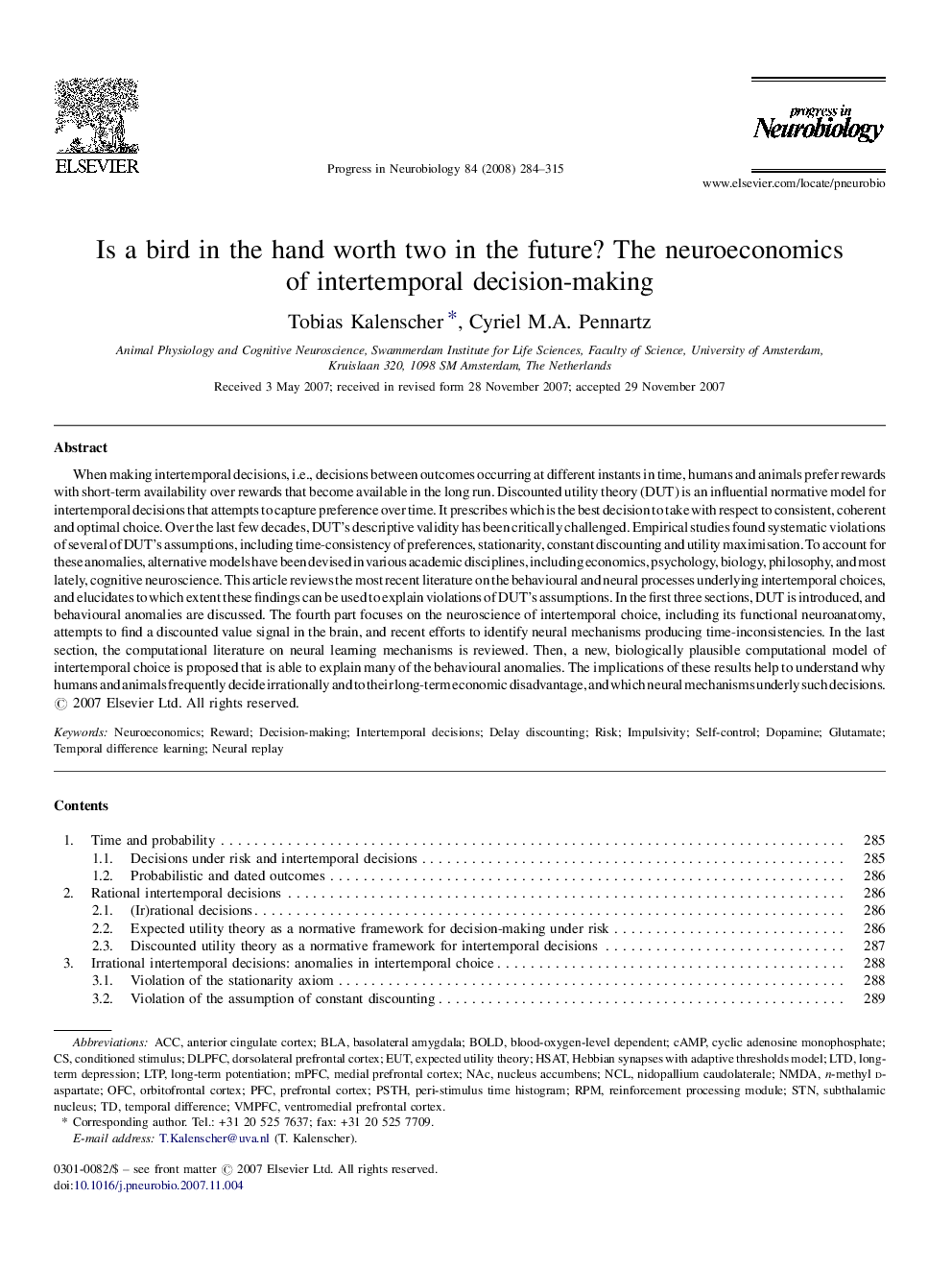| کد مقاله | کد نشریه | سال انتشار | مقاله انگلیسی | نسخه تمام متن |
|---|---|---|---|---|
| 4353926 | 1298521 | 2008 | 32 صفحه PDF | دانلود رایگان |
عنوان انگلیسی مقاله ISI
Is a bird in the hand worth two in the future? The neuroeconomics of intertemporal decision-making
دانلود مقاله + سفارش ترجمه
دانلود مقاله ISI انگلیسی
رایگان برای ایرانیان
کلمات کلیدی
NACNMDAMPFCDLPFCSTNBOLDOFCPSTHvmPFCBLAEUTNCLN-methyl d-aspartateHSATRPMPFCNidopallium caudolateraleACCbasolateral amygdala - amygdala basolateralcAMP - cAMPCyclic adenosine monophosphate - آدنوزین مونوفسفات Cycliclong-term depression - افسردگی طولانی مدتNeuroeconomics - اقتصاد عصبیDelay discounting - تخفیف تاخیرDecision-making - تصمیم گیریTemporal difference - تفاوت زمانیlong-term potentiation - تقویت درازمدتLTP - تقویت طولانی مدت یا LTP impulsivity - تکانشگریRisk - خطرSelf-control - خودکنترلیDopamine - دوپامینprefrontal cortex - قشر prefrontalorbitofrontal cortex - قشر اوربیتوفرنتالanterior cingulate cortex - قشر سینگولیت قدامی، کورتکس سینگولیت قدامیmedial prefrontal cortex - قشر غده پروسترولdorsolateral prefrontal cortex - قشر پیشانی غدد درون رحمیLTD - محدودconditioned stimulus - محرک شرطیExpected utility theory - نظریه ی مورد انتظارNucleus accumbens - هسته accumbensSubthalamic nucleus - هسته ی زیرهالامیکperi-stimulus time histogram - هیستوگرام زمان پری محرکblood-oxygen-level dependent - وابسته به سطح اکسیژن خونReward - پاداشventromedial prefrontal cortex - کورتکس prefrontal ventromedialglutamate - گلوتاماتTemporal difference learning - یادگیری تفاوت زمانی
موضوعات مرتبط
علوم زیستی و بیوفناوری
علم عصب شناسی
علوم اعصاب (عمومی)
پیش نمایش صفحه اول مقاله

چکیده انگلیسی
When making intertemporal decisions, i.e., decisions between outcomes occurring at different instants in time, humans and animals prefer rewards with short-term availability over rewards that become available in the long run. Discounted utility theory (DUT) is an influential normative model for intertemporal decisions that attempts to capture preference over time. It prescribes which is the best decision to take with respect to consistent, coherent and optimal choice. Over the last few decades, DUT's descriptive validity has been critically challenged. Empirical studies found systematic violations of several of DUT's assumptions, including time-consistency of preferences, stationarity, constant discounting and utility maximisation. To account for these anomalies, alternative models have been devised in various academic disciplines, including economics, psychology, biology, philosophy, and most lately, cognitive neuroscience. This article reviews the most recent literature on the behavioural and neural processes underlying intertemporal choices, and elucidates to which extent these findings can be used to explain violations of DUT's assumptions. In the first three sections, DUT is introduced, and behavioural anomalies are discussed. The fourth part focuses on the neuroscience of intertemporal choice, including its functional neuroanatomy, attempts to find a discounted value signal in the brain, and recent efforts to identify neural mechanisms producing time-inconsistencies. In the last section, the computational literature on neural learning mechanisms is reviewed. Then, a new, biologically plausible computational model of intertemporal choice is proposed that is able to explain many of the behavioural anomalies. The implications of these results help to understand why humans and animals frequently decide irrationally and to their long-term economic disadvantage, and which neural mechanisms underly such decisions.
ناشر
Database: Elsevier - ScienceDirect (ساینس دایرکت)
Journal: Progress in Neurobiology - Volume 84, Issue 3, March 2008, Pages 284-315
Journal: Progress in Neurobiology - Volume 84, Issue 3, March 2008, Pages 284-315
نویسندگان
Tobias Kalenscher, Cyriel M.A. Pennartz,